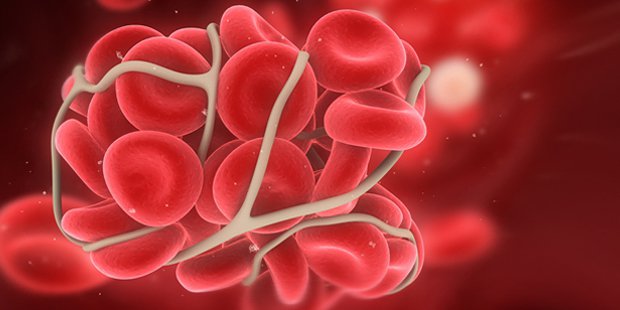Formation and prevention of blood clots in cancer patients
Thrombosis in cancer patients is a serious complication, the second leading cause of death in cancer patients and severely affects quality of life. Thrombosis usually occurs after the cancer has been diagnosed but can also be the first symptom or before the cancer is discovered.
1. How are blood clots formed?
Blood clots that form and travel to other sites in the body, including:
Veins: deep vein thrombosis Lungs: pulmonary embolism Thrombotic arterial embolism (less common but very common) serious if it occurs): like a stroke or heart attack
2. Mechanism of blood clot formation in cancer patients
Thrombosis in cancer patients is the result of interaction between tumor cells, hemostasis and neovascularization.
The pathophysiology of blood clots in cancer patients is complex and still poorly understood. Cancer patients often have hypercoagulability due to the synergistic effect of 3 main factors: blood stasis, damage to the vessel wall and increased coagulation.
Blood stagnation: because the patient has to rest in bed or because the tumor is compressed. Injury to the vessel wall: Due to the invasion of cancer cells, chemotherapy or other interventions. Injury to the vessel wall due to the following causes: blood vessels are compressed from the outside by the tumor; Enlarged lymph nodes or the use of a central venous line in chemotherapy. Hypercoagulability: due to the release of clotting factors from cancer cells, it affects platelet function and coagulation cascade.

Do giải phóng các yếu tố đông máu từ tế bào ung thư gây ảnh hưởng đến chức năng tiểu cầu và dòng thác đông máu
3. Risk factors for blood clot formation in cancer patients
Patient-related factors include: advanced age, female sex, obesity (BMI > 35kg/m2), black race, co-morbidities (infections, lung and kidney disease, abnormal status) The factors associated with malignancy include: tumor location, stage of disease, tumor histology, degree of tumor differentiation. Tumor and time of diagnosis
Tumor location: very high risk of thrombosis: tumors in pancreas, brain and stomach High risk of thrombosis: Cancer of lung, kidney, colon, uterus, bladder and testicles Low risk of thrombosis: prostate and breast cancer Stage of disease: advanced or metastatic cancer is a major risk factor for thrombosis Tumor: adenocarcinoma has a higher risk of thrombosis than squamous cell carcinoma Degree of tumor differentiation: risk of thrombosis is higher in poorly differentiated or undifferentiated tumors Timing of diagnosis: risk Thrombosis in cancer patients highest within 3 days up to 6 months after diagnosis. Treatment-related factors: Cancer drugs (chemotherapy, hormones, anti-angiogenic drugs and erythropoiesis-stimulating drugs) and other interventions (surgery, intravenous catheterization) are increases the risk of blood clots.
4. Clinical symptoms of thrombosis in cancer patients
Signs depend on the location and degree of thrombosis: venous or arterial thrombosis, location of occlusion, degree of occlusion,...
Patients may have the following symptoms:
Swelling of one limb : arm or leg Thromboembolism site pain: arm or leg Shortness of breath or chest pain Low blood oxygen level
5. Tests to help detect blood clots in cancer patients
Doppler ultrasound: detect reduced flow in the distal area of the thrombus site Computed tomography: often contrast CT scan to diagnose pulmonary artery thrombosis Evaluation of pulmonary ventilation-perfusion: Aim diagnosis of pulmonary artery thrombosis Angiography: helps detect blood clots in the arteries
6. Prevention of blood clots in cancer patients

Khám bệnh để phòng tránh nặng hơn
Prophylactic anticoagulation should be indicated for cancer patients who are hospitalized due to acute medical illness or limited mobility. Contraindicated in the following cases: recent surgery, local bleeding, platelet count <50,000/mm3
Outpatient cancer patients receiving chemotherapy and able to walk on their own: patient will be evaluated Assess the risk of thrombosis using the Khorana scale. Routine thromboprophylaxis is not recommended in cancer patients who are able to walk on their own, except in the following cases: multiple myeloma; advanced pancreatic cancer. The risk of thrombosis should be assessed at the start of chemotherapy and periodically thereafter.
Vinmec International General Hospital is one of the hospitals that not only ensures professional quality with a team of leading medical doctors, modern equipment and technology, but also stands out for its examination and consultation services. comprehensive and professional medical consultation and treatment; civilized, polite, safe and sterile medical examination and treatment space.
Customers can directly go to Vinmec Health system nationwide to visit or contact the hotline here for support.
Reference article source: Vietnam Society of Cardiology
SEE MORE:
Thrombosis (blood clot): Causes, symptoms, diagnosis and treatment Limit blood clot formation after surgery Multiple tumors marrow: Causes, symptoms






